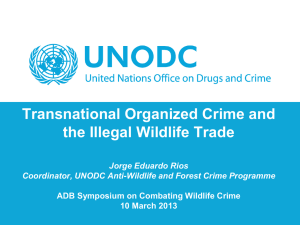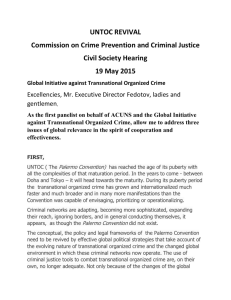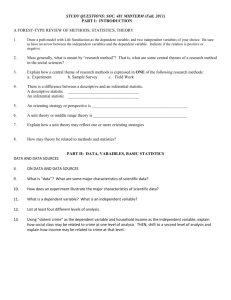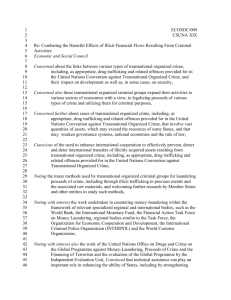Pubp 764 - Terrorism, Transnational Crime and Corruption
advertisement
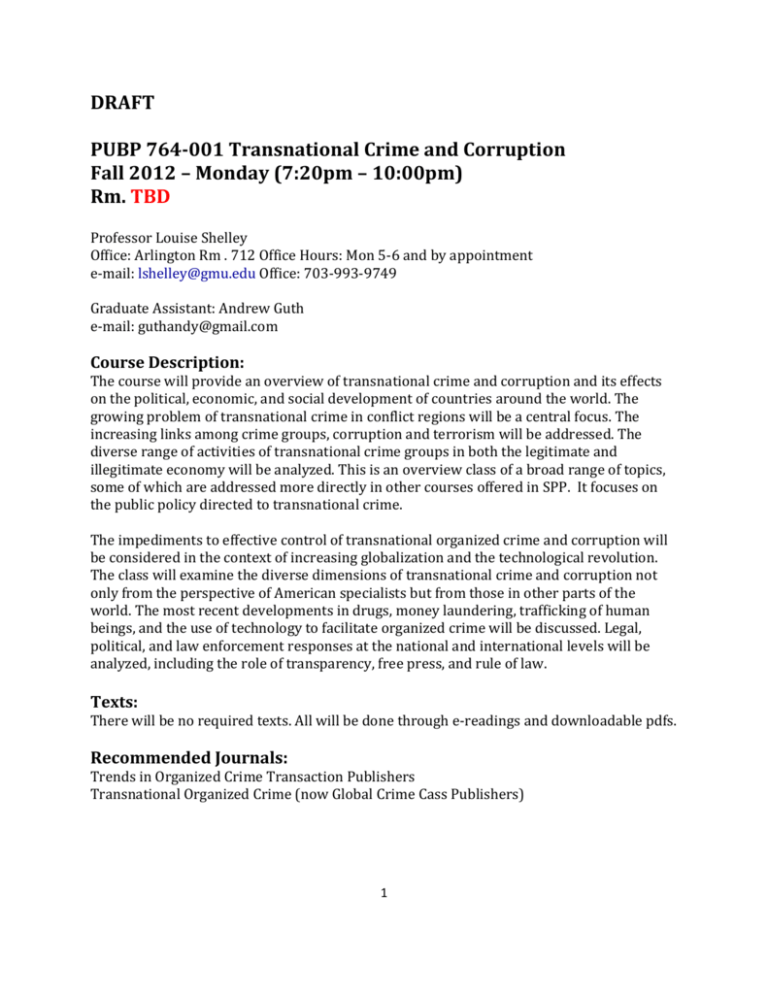
DRAFT PUBP 764-001 Transnational Crime and Corruption Fall 2012 – Monday (7:20pm – 10:00pm) Rm. TBD Professor Louise Shelley Office: Arlington Rm . 712 Office Hours: Mon 5-6 and by appointment e-mail: lshelley@gmu.edu Office: 703-993-9749 Graduate Assistant: Andrew Guth e-mail: guthandy@gmail.com Course Description: The course will provide an overview of transnational crime and corruption and its effects on the political, economic, and social development of countries around the world. The growing problem of transnational crime in conflict regions will be a central focus. The increasing links among crime groups, corruption and terrorism will be addressed. The diverse range of activities of transnational crime groups in both the legitimate and illegitimate economy will be analyzed. This is an overview class of a broad range of topics, some of which are addressed more directly in other courses offered in SPP. It focuses on the public policy directed to transnational crime. The impediments to effective control of transnational organized crime and corruption will be considered in the context of increasing globalization and the technological revolution. The class will examine the diverse dimensions of transnational crime and corruption not only from the perspective of American specialists but from those in other parts of the world. The most recent developments in drugs, money laundering, trafficking of human beings, and the use of technology to facilitate organized crime will be discussed. Legal, political, and law enforcement responses at the national and international levels will be analyzed, including the role of transparency, free press, and rule of law. Texts: There will be no required texts. All will be done through e-readings and downloadable pdfs. Recommended Journals: Trends in Organized Crime Transaction Publishers Transnational Organized Crime (now Global Crime Cass Publishers) 1 Recommended Websites: 1) See Professor Mark Galeotti’s syllabus for his class on transnational crime that has many fine references on it https://docs.google.com/file/d/0B47Vp6fcXiaoZTUzZTg5NWItNTAxYS00NGQ4LTh mMjQtNmVkOGI3NWQ4ZjFl/edit?pli=1 2) See Links and publications section of TraCCC website: www.traccc.gmu.edu 3) Klaus von Lampe’s website: http://www.organized-crime.de/ 4) National Criminal Justice Reference Service, many publications on transnational crime: https://www.ncjrs.gov/App/Publications/AlphaList.aspx 5) See links and publication sections: http://nathanson.osgoode.yorku.ca/databases/ 6) See newsletters and past issues of this Dutch based group: www.ciroc.org 7) United Nations Office on Drugs and Crime: www.unodc.org 8) US State Department narcotics reports: http://www.state.gov/j/inl/rls/nrcrpt/2012/ 9) Organized crime in Latin America, WOLA website: http://www.wola.org/index.php?option=com_content&task=viewp&id=588&Itemi d=2 10) Bertil Lintner’s writings on organized crime in Asia: http://www.asiapacificms.com/articles/ 11) International Crisis Group: http://www.crisisgroup.org/ 12) International Crisis Group (Latin America and Crime and Politics): http://www.crisisgroupblogs.org/crimeandpolitics/ 13) Organized Crime and Corruption Reporting Project: www.reportingproject.net/ 14) Organized Crime in the Americas: www.insightcrime.org/ 15) Silk Road Studies Institute: http://www.silkroadstudies.org/new/ 16) Institute for Security and Development Policy (Central Asia and Baltic Region): www.isdp.eu/ 17) Unicri (United National Interregional Crime and Justice Research Institute http://www.unicri.it/ 18) Council on Foreign Relations: a. Global Regime for Transnational Crime, http://www.cfr.org/globalgovernance/global-regime-transnational-crime/p28656 b. International Efforts not up to Combating Transnational Criminals, http://www.cfr.org/international-crime/international-efforts-not-up-combatingcriminals-shows-cfr-interactive/p28684 19)International Organization for Migration (IOM) (counter-trafficking part of website): http://www.iom.int/jahia/Jahia/pid/748 E-Reserves: Instructions on how to access Go to http://library.gmu.edu Click on “Reserves” Select a course: “PUBP764 section 001” Select an instructor: “Shelley, Louise” Enter the password: TBD (all lowercase) Click on “Submit” 2 Course Requirements: Reading A significant amount of reading is required for the course. Students who fall behind will have a difficult time catching up. Students are expected to do the assigned reading in advance of the class. The class will presume knowledge of the readings assigned for that week. Students are expected to keep up with news on transnational crime that is reported in newspapers and on-line sources and to discuss recent developments in class each week. Each week two students will report briefly on recent transnational crime developments in the press during the past week. Attendance (20%): Students will be expected to attend the whole class. Attendance will be taken. Your grade will be reduced for unexplained and unexcused absences. Please inform me if you will be absent from a class. Exam (25%): There will be a mid-term exam on November 19th. It will combine short identifications and long essays. The exam will draw on the readings, class lectures, and discussions. Class Project (20%): The class presentations begin on TUESDAY October 9th: Written and Oral Presentations, presentations will be chosen by the student in coordination with the instructor. In each presentation the student will show how organized crime is connected to one of the following sectors: 1) Automotive, 2) Aviation, Travel, & Tourism, 3) Banking & Capital Markets, 4) Consumer, 5) Health, 6) Insurance & Asset Management, 7) Logistics & Supply Chain, 8) Media, Entertainment, & Information, 9) Mining & Metals, 10) Private Fund Managers, 11) Public & Institutional Investors, 12) Real Estate, 13) Renewable Energy, 14) Telecom 15) Computer industry 16) Pharmaceuticals. . Presentation should be a PowerPoint with a bibliography that will be handed in the day of the presentation (20%). Term Paper Due December 17th (35%): Length 20-25 pages, standard reference format The topic will be chosen after consultation with the instructor. It can use insights that are obtained from the oral presentation. It should discuss a topic related to transnational crime and should develop a bibliography of diverse sources. Topics might include such topics as: The rise of drug trafficking in Afghanistan, Examining the role of natural resources in perpetuating conflict. How do crime groups negatively affect the environment? You can choose to focus on a particular area of criminal activity, a region of the world or a strategy or set of strategies used to address the problem. 3 Grading: Students will be graded according to the following criteria: Class attendance and participation 20% Mid-Term Exam 25% Class Project 20% Term Paper 35% Special Needs If you are a student with a disability and you need academic accommodations, please see me and contact the Disability Resource Center (DRC) at 993-2474. All academic accommodations must be arranged through the DRC. SPP Journal "New Voices in Public Policy: I will consider nominating the very best papers in this course for publication in New Voices in Public Policy. New Voices is a student- and faculty-reviewed journal that shares SPP's finest student work with the rest of the world." Plagiarism The profession of scholarship and the intellectual life of a university as well as the field of public policy inquiry depend fundamentally on a foundation of trust. Thus any act of plagiarism strikes at the heart of the meaning of the university and the purpose of the School of Public Policy. It constitutes a serious breach of professional ethics and it is unacceptable. Plagiarism is the use of another’s words or ideas presented as one’s own. It includes, among other things, the use of specific words, ideas, or frameworks that are the product of another’s work. Honesty and thoroughness in citing sources is essential to professional accountability and personal responsibility. Appropriate citation is necessary so that arguments, evidence, and claims can be critically examined. Plagiarism is wrong because of the injustice it does to the person whose ideas are stolen. But it is also wrong because it constitutes lying to one’s professional colleagues. From a prudential perspective, it is shortsighted and self-defeating, and it can ruin a professional career. The faculty of the School of Public Policy takes plagiarism seriously and has adopted a zero tolerance policy. Any plagiarized assignment will receive an automatic grade of “F.” This may lead to failure for the course, resulting in dismissal from the University. This dismissal will be noted on the student’s transcript. For foreign students who are on a university-sponsored visa (eg. F-1, J-1 or J-2), dismissal also results in the revocation of their visa. To help enforce the SPP policy on plagiarism, all written work submitted in partial fulfillment of course or degree requirements must be available in electronic form so that it can be compared with electronic databases, as well as submitted to commercial services to which the School subscribes. Faculty may at any time submit student’s work without prior permission from the student. Individual instructors may require that written work be submitted in electronic as well as 4 printed form. The SPP policy on plagiarism is supplementary to the George Mason University Honor Code; it is not intended to replace it or substitute for it. Weekly Schedule: Week 1: August 27 - Introduction to the Course Why are transnational crime and corruption important public policy concerns and how do they relate to national security and peace keeping? How does transnational crime affect international commerce? Why does an understanding of these phenomena require a multidisciplinary (history, political science, economics, sociology and security studies) perspective? How is transnational crime related to the prolongation of conflict? What are the linkages between transnational crime, corruption and terrorism? How is transnational crime linked to international commerce? Required video: 1) http://www.cfr.org/global-governance/global-governancemonitor/p18985#/Crime/Overview%20Video September 3 – NO CLASS/LABOR DAY Week 2: September 10 - Conceptualizing the Problem: How has it been affected by globalization The rise of transnational crime has been tied to globalization, the rise of non-state actors, the retreat of the state and the presence of weak states. This week we will examine transnational crime in terms of all these trends, but also show that it often has deep historical roots within many societies that are overlooked in many current analyses that focus on the recent rise of the phenomena. The implications of the rise of transnational crime for state sovereignty are central. Why do organized crime and corruption look so different to those in the transitional and developing world from those in the developed world? Why has transnational organized crime increased with globalization and the new technological revolution? How is it related to national sovereignty and the strength of the state? Required Readings: 1) Louise Shelley, Chris Corpora and John Picarelli, "Global Crime, Inc," Beyond Sovereignty: Issues for a Global Agenda, 4th Edition. (ed.) Maryann E. Cusimano-Love, 2011, pp. 141-169 (see reserves) 2) Louise Shelley, "Transnational Organized Crime: An Imminent Threat to the Nation State?," Journal of International Affairs, Vol. 48, No. 2, p. 463-489, Winter 1995 (ejournals). 3) Susan Strange, "Organized Crime: the Mafias," Retreat of the State: The Diffusion of Power in the World Economy, p. 110-121, 1996 (see reserves). 4) UNODC, Globalization of Crime: Transnational Organized Crime Threat Assessment, p.121. http://www.unodc.org/documents/data-and-analysis/tocta/TOCTA_Report_2010_low_res.pdf 5 Week 3: September 17 - Who are the Transnational Criminals? **Choose Class Presentation Topic and Date** We will examine who are the transnational criminals and why they are among the major beneficiaries of globalization. Who are the high level facilitators who make this crime possible? How do political leaders interact with transnational crime? This discussion will analyze the network structure of many of the new groups in comparison with the hierarchical structure of more traditional organized crime groups. Required Readings: 1) Moisés Naím, “Mafia States,” Foreign Affairs May/June 2012, pp. 100-111 (e-journals). 2) Response by Peter Andreas, “Measuring the Mafia-Style Menace,” Foreign Affairs, July/August 2012 (e-journals). 3) Australian Crime Commission, “Professional Facilitators of Crime,” http://www.crimecommission.gov.au/sites/default/files/files/facilitators.pdf 4) Phil Williams, Transnational Criminal Networks , in Networks and Netwars, eds. Joan Arquilla and David Ronfeldt, Rand, 2001, pp. 61-97, http://www.rand.org/content/dam/rand/pubs/monograph_reports/MR1382/MR1382.ch3.pdf 5) Margaret Beare, Global Transnational Crime: Canada and China, pp.1-8. http://www.opencanada.org/wp-content/uploads/2011/05/Global-Transnational-Crime_-Canadaand-China-Margaret-Beare.pdf 6) Peter Gastrow, “Termites at Work,” (Summary Report), pp. 3-5. http://reliefweb.int/sites/reliefweb.int/files/resources/Full_Report_2562.pdf 7) Financial Action Task Force (FATF), Money Laundering Risks Arising from Trafficking of Human Beings and Smuggling of Migrants (2011), pp.12-13, http://www.fatfgafi.org/media/fatf/documents/reports/Trafficking%20in%20Human%20Beings%20and%20Smuggli ng%20of%20Migrants.pdf Week 4: September 24 - The Impact of Transnational Crime and Corruption **Submit term paper title, short description and sample bibliography** Transnational crime represents a new form of authoritarianism. Transnational crime affects every aspect of life in the contemporary world, to an extent that is not yet fully recognized. Not only does it affect individual security, but, through the proliferation of narcotics and counterfeit drugs, organized crime groups have a major impact on health. The financing of elections and the infiltration of criminals into the political process in many countries undermines democracy and citizen faith in government. Intimidation of muckraking journalists by transnational crime groups is presently one of the greatest threats to journalism and independent media. The purchasing of journalists by organized criminals severely compromises the integrity of the press in many countries. Organized crime’s exploitation of labor and its ever-greater role in the smuggling and trafficking of human beings has led to large-scale labor violations and the reemergence of slavery in regions where it had been eradicated. How does organized crime and corruption affect 6 economic development? How does it undermine the environment? How does it affect human rights, such as freedom of the press, labor rights, and the electoral process? How does it affect women and the poor disproportionately? What is the impact on the environment? What is the impact of corruption on the foreign aid process? How does it lead to the prolongation of conflict? Required Readings: 1) Louise Shelley, “Transnational Organized Crime: The New Authoritarianism,” in The Illicit Global Economy, pp.25-6, 30-47 (see reserves) 2) UNODC, Globalization of Crime: Transnational Organized Crime Threat Assessment, pp. 25-36; 173-93, http://www.unodc.org/documents/data-and-analysis/tocta/TOCTA_Report_2010_low_res.pdf 3) Louise Shelley, Human Trafficking: A Global Perspective, ch. 2, pp.59-67; 76-8 (see reserves) 4) Committee to Protect Journalists, Getting Away with Murder, http://www.cpj.org/reports/2012/04/impunity-index-2012.php#more 5) Susan Breitkopf, “The Looting of Iraq’s Antiquities,” http://www.aam-us.org/pubs/mn/MN_JF07_lost-iraq.cfm 6) Raymond Fisman and Edward Miguel, Economic Gangsters Corruption, Violence and the Poverty of Nations Princeton University Press, 2008, ch. 1, pp1-21 (reserves) Week 5: October 1 – Transnational Crime and Technology Transnational crime is able to function because there has been a decline of borders, a rise of ease of communications through the internet and advanced communications as well as high level facilitators. How does organized crime use the internet and encryption? How does it market its goods through the internet? How does it use sophisticated computer specialists to evade detection? Required Readings: 1) Michael Glenny, McMafia: A Journey Through the Criminal Underworld, pp. 264-274 (on cybercrime) (reserves) 2) World Economic Forum (2012). “Organised Crime Enablers,” pp.8-13. http://www3.weforum.org/docs/WEF_GAC_OrganizedCrimeEnablers_Report_2012.pdf 3) Microsoft for Public Safety & National Security, “Malicious Software Crime,” http://www.microsoft.com/government/ww/safety-defense/initiatives/Pages/dcu-economiccrime.aspx 4) UNODC, Globalization of Crime: Transnational Organized Crime Threat Assessment, p. 203-218. http://www.unodc.org/documents/data-and-analysis/tocta/TOCTA_Report_2010_low_res.pdf 5) Nicolas Christin, Traveling the Silk Road: A measurement analysis of a large anonymous online marketplace. http://arxiv.org/pdf/1207.7139.pdf 6) Ross Anderson, Chris Barton, Rainer Bohme, Richard Clayton, Michel J.G. van Eeten, Michael Levi, Tyler Moore, Stefan Savage (2012). “Measuring the Cost of Cybercrime,” http://weis2012.econinfosec.org/papers/Anderson_WEIS2012.pdf 7 Week 6: Tuesday October 9 (Monday is a holiday) - Transnational Crime and Conflict Regions: Threat to Stability **Oral Presentations Start** Transnational Crime as a Security Issue: Overview Transnational crime is increasingly seen as a security threat. In the United States, the focus of concern is primarily on terrorism, whereas in the European context transnational crime is more of a concern. The reasons for the divergence in this perspective will be analyzed. In many developing and transitional countries, the corruption of the military and law enforcement and their involvement with organized crime and terrorist groups is a major concern to personal and national security. Regional conflicts are prolonged because of the crime problem and rebel groups. In a world where regional conflicts have overtaken superpower conflicts, the importance of transnational crime groups in financing and perpetuating regional conflicts has acquired increasing importance. What types of criminal activity are most likely to support conflict? How does the illicit international arms trade contribute to instability? How does corruption facilitate the transnational crime in conflict regions? What is the role of multinational organizations in this illicit activity? Required Readings: 1) UNODC, Globalization of Crime: Transnational Organized Crime Threat Assessment, p. 221-272. http://www.unodc.org/documents/data-and-analysis/tocta/TOCTA_Report_2010_low_res.pdf 2) Woodrow Wilson Center, Organized Crime in Central America: The Northern Triangle, executive summary. http://www.wilsoncenter.org/sites/default/files/LAP_single_page.pdf 3) DNI statement to Congress in Feb 2010 – “Growing Threat from International Organized Crime,” pp. 44-45. http://www.dni.gov/files/documents/Newsroom/Testimonies/20100202_testimony.pdf 4) Rachel Locke, "Organized Crime, Conflict and Fragility: A New Approach, International Peace Institute (2012), pp. 1-9. http://www.humansecuritygateway.com/documents/IPI_OrganizedCrimeConflictandFragility.pdf 5) Peter Gastrow, “Termites at Work” (Summary Report) pp.1-3. http://reliefweb.int/sites/reliefweb.int/files/resources/Full_Report_2562.pdf Week 7: October 15 - Human Trafficking and Smuggling Why is trafficking in human beings an increasingly severe problem? How does it differ from other forms of organized crime? How does the smuggling and trafficking of men and women differ? How does trafficking in women differ by region? Why is it such a difficult crime to investigate? What is required to combat this crime? Required Readings: 1) Louise Shelley, “The Relationship of Drug and Human Trafficking: A Global Perspective” European Journal on Criminal Policy and Research: Volume 18, Issue 3 (2012), Page 241253 (e-journals). 8 2) UNODC, Globalization of Crime: Transnational Organized Crime Threat Assessment, pgs. 39-77 http://www.unodc.org/documents/data-and-analysis/tocta/TOCTA_Report_2010_low_res.pdf 3) Jay S. Albanese, Human Trafficking chapter in Transnational Crime and the 21st Century, pp. 49-65 (see reserves). 4) Gastrow, P. (2011). "Human Trafficking and the Smuggling of Migrants." Termites at Work (Comprehensive Report), Chapter 4, pp. 59-73. http://www.google.com/url?sa=t&rct=j&q=&esrc=s&source=web&cd=1&ved=0CFQQFjAA&url=http %3A%2F%2Fkms1.isn.ethz.ch%2Fserviceengine%2FFiles%2FISN%2F138814%2Fipublicationdocumen t_singledocument%2Ff408c497-b334-4d33-93ea5d6753d224b4%2Fen%2Fepub_1.pdf&ei=2H8pUJ6kOcqL0QHv4YGADw&usg=AFQjCNF6SIcoGVOGv2 oHGb8-BQ_pG6xqzA&sig2=juXOHFx-8uKOoytxnoW5-g Week 8: October 22 - Guest speaker? Drug Trafficking What is the nature of the drug problem? Why is it so prominent in the general problem of organized crime? How do different criminal organizations work together to perpetuate this crime? How has the drug trade affected countries where the traffickers are a dominant political and economic force? What are the new routes and new products? Required Readings: 1) Woodrow Wilson Center, Organized Crime in Central America: The Northern Triangle (Dudley chapter, pgs. 18-61) http://www.wilsoncenter.org/sites/default/files/LAP_single_page.pdf 2) World Drug Report for 2010, Executive Summary http://www.unodc.org/documents/wdr/WDR_2010/Executive_summary.pdf 3) UNODC, Globalization of Crime: Transnational Organized Crime Threat Assessment, chapters 4 and 5, pp.81-126. http://www.unodc.org/documents/data-and-analysis/tocta/TOCTA_Report_2010_low_res.pdf 4) State Department's International Narcotics Control Report (2012), Volume 1, pp. 14-21 and look at countries that may interest you. www.state.gov/j/inl/rls/nrcrpt/2012/ 5) Patrick Radden Keefe: a. Cocaine Incorporated, June 15, 2012, http://www.nytimes.com/2012/06/17/magazine/how-a-mexican-drug-cartelmakes-its-billions.html?pagewanted=all b. Interview with Keefe, http://6thfloor.blogs.nytimes.com/2012/06/18/behind-the-cover-storypatrick-radden-keefe-on-the-sinaloa-drug-cartel/ 6) Center for American Progress, the “High Costs of Afghan’s Opium Economy,” http://www.americanprogress.org/issues/2012/06/afghan_opium.html/ 9 Week 9: October 29 - Organized Environmental Crime Transnational criminals function as important traders in endangered species, timber and CFCs pose major environmental threats and undermine sustainable development. They are also active in the improper disposal of hazardous waste. They are also involved in illegal carbon trading and defrauding programs for sustainable energy. Required Readings: 1) UNODC, Globalization of Crime: Transnational Organized Crime Threat Assessment, pgs. 149-169 http://www.unodc.org/documents/data-and-analysis/tocta/TOCTA_Report_2010_low_res.pdf 2) Gastrow, P. (2011). “Trafficking in Wildlife Products.” Termites at Work (Comprehensive Report). Chapter 3, pp.49-58. http://www.google.com/url?sa=t&rct=j&q=&esrc=s&source=web&cd=1&ved=0CFQQFjAA&url=http %3A%2F%2Fkms1.isn.ethz.ch%2Fserviceengine%2FFiles%2FISN%2F138814%2Fipublicationdocumen t_singledocument%2Ff408c497-b334-4d33-93ea5d6753d224b4%2Fen%2Fepub_1.pdf&ei=2H8pUJ6kOcqL0QHv4YGADw&usg=AFQjCNF6SIcoGVOGv2 oHGb8-BQ_pG6xqzA&sig2=juXOHFx-8uKOoytxnoW5-g 3) Rob White, Transnational Environmental Crime: Toward an eco-global criminology, pp.1-18 (see reserves) 4) Serious Organized Crime Agency (SOCA). SOCA Annual Report and Accounts 2011/12, p.20. http://www.soca.gov.uk/about-soca/library 5) Climate Spectator (2011). “Double Trouble for Carbon Markets.” http://www.climatespectator.com.au/commentary/double-trouble-carbon-markets 6) Interpol, “Electronic Waste and Organized Crime,” 2009, pp.33-37. http://www.google.com/url?sa=t&rct=j&q=&esrc=s&source=web&cd=1&ved=0CF0QFjAA&url=http %3A%2F%2Fwww.interpol.int%2Fcontent%2Fdownload%2F5367%2F45070%2Fversion%2F1%2Ffile %2FWastereport.pdf&ei=WIcpUOGQF8X06AHF_4GIBA&usg=AFQjCNHe6LyRv3DTXs7dBSTV_WWkAS Kk8Q&sig2=IoxnFfKV_g0_zXNhr2vrIA Required Videos: 1) Carbon Credits video: http://www.eia-international.org.php5-20.dfw1-1.websitetestlink.com/ourwork/environmental-crime-and-governance/carbon-trade 2) Earth Focus in Link TV, Baby Elephant Smuggling exposed, http://www.linktv.org/video/7852/baby-elephant-smuggling-exposed Suggested Readings: 1) Traffic website—for more research done by Traffic see: http://www.traffic.org/general-topics/ 10 Week 10: November 5 - Transnational Crime, Corruption and Terrorism What linkages exist between transnational crime and terrorism? Do these relationships exist outside the drug trade? Why has the term narco-terrorism acquired such currency? Has their relationship changed over time? What are their differences in goals? Are there differences in funding? Required Readings: 1) Louise Shelley, corruption chapter of book in progress (see reserves). 2) Tamara Makarenko, “’The ties that bind’: uncovering the relationship between organized crime and terrorism,” in Global Organized Crime eds. D. Siegel, H. van de Bunt and D. Zaitch, pp. 159-73 (see reserves). 3) Michael P. Arena, “Hizballah’s Global Criminal Operations,” in Criminal-States and Criminal-Soldiers ed. Robert J. Bunker, pp. 126-42 (see reserves) 4) John Rollins and Liana Sun Wyler, “International Terrorism and Transnational Crime” http://fpc.state.gov/documents/organization/141615.pdf, pp. 1-20. 5) Louise Shelley, “Trafficking in Nuclear Materials: Criminals and Terrorists,” Global Crime, vol. 7, nos. 3-4 (August-November 2006), pp.544-560. 6) Jeffrey Dressler (2012), Afghanistan Report 9, "The Haqqani Network," pp. 8-19, 39-41. http://www.understandingwar.org/sites/default/files/Haqqani_StrategicThreatweb_29MAR_0.pdf November 12th - NO CLASS We will make up this class during a study day. Week 11: November 19 - MIDTERM EXAM Weeks 12: November 26 - Business of Transnational Crime and Money Laundering International organized crime groups and terrorists are now major actors in the international economy. What is money laundering and what are its stages? How is it affected by increasing technology and the increasing sums of money involved? How is offshore havens part of the regulatory problem? Why is it such an important part of the fight with organized crime? Required Readings: 1) State Department 2012 International Narcotics Report, Part II: Money Laundering and Financial Crimes, pp.1-2. http://www.state.gov/j/inl/rls/nrcrpt/2012/ 2) Gastrow, P. (2011). Termites at Work (Comprehensive Report), pp. 89-102. http://www.google.com/url?sa=t&rct=j&q=&esrc=s&source=web&cd=1&ved=0CFQQF jAA&url=http%3A%2F%2Fkms1.isn.ethz.ch%2Fserviceengine%2FFiles%2FISN%2F13 8814%2Fipublicationdocument_singledocument%2Ff408c497-b334-4d33-93ea5d6753d224b4%2Fen%2Fepub_1.pdf&ei=2H8pUJ6kOcqL0QHv4YGADw&usg=AFQjCN F6SIcoGVOGv2oHGb8-BQ_pG6xqzA&sig2=juXOHFx-8uKOoytxnoW5-g 3) idefense, “Money Mules: Sophisticated Global Cyber Criminal Operations.” http://complianceandprivacy.com/WhitePapers/iDefense_MoneyMules_20060329.pdf 11 4) John Paul Rathbone, “Money Launderers: Taken to the Cleaners,” Financial Times. July 20, 2012. 5) Moisés Naím, Illicit: How Smugglers, Traffickers and Copycats are Hijacking the Global Economy ch.7, pp.131-56 (reserves). 6) Financial Action Task Force (FATF), Money Laundering Risks Related to Trafficking of Human Beings and Smuggling of Migrants, pp. 31-37. http://www.fatfgafi.org/media/fatf/documents/reports/Trafficking%20in%20Human%20Beings%20and%20Smuggli ng%20of%20Migrants.pdf Week 13 and 14: December 3 and 10 - Combating Transnational Organized Crime and Corruption What is the future of organized crime and what are the US and global strategies needed to address it? The class will address the strategies that are needed to combat the phenomenon in fragile states. We will also examine many other strategies that must be part of this strategy such as free and accountable journalism, following the money trail, and reducing demand for illicit commodities. How can businesses become more involved in combating transnational crime? What can be done to combat the corruption that facilitates transnational crime? Required Readings: 1) White House, Strategy to Combat Transnational Organized Crime Addressing Converging Threats to National Security, pp.13-28. http://www.whitehouse.gov/sites/default/files/Strategy_to_Combat_Transnational_Organized_Cri me_July_2011.pdf 2) Rosemary Armao, “Covering Corruption: The Difficulties of Trying to Make a Difference,” Executive Summary and pp. 21-33 (role of journalists). http://cima.ned.org/sites/default/files/CIMA-Covering_Corruption-Report.pdf 3) Rachel Locke, Organized Crime, Conflict and Fragility: A New Approach, International Peace Institute 2012, pp.9-16. http://www.humansecuritygateway.com/documents/IPI_OrganizedCrimeConflictandFragility.pdf 4) UNODC, Globalization of Crime: Transnational Organized Crime Threat Assessment, pp. 275-78. http://www.unodc.org/documents/data-andanalysis/tocta/TOCTA_Report_2010_low_res.pdf 5) Peter Andreas and Ethan Nadelmann, “The Internationalization of Crime Control,” in Crime and Global Political Economy, ed. H. Richard Friman, pp.21-33 (reserves). 6) Michael Glenny, McMafia: A Journey Through the Criminal Underworld, pp. 343-46 (reserves) 7) E. Chris Johnson Jr., “Michigan Lawyers in the Fight Against Slavery,” Michigan Bar Journal, June 2012, pp.22-26. (working with the business community and supply chains). http://www.michbar.org/journal/pdf/pdf4article2039.pdf 8) Jay S. Albanese, in Transnational Crime and the 21st Century , pp. 133-138 (reserves). 12 9) Global Witness (2009). Ch. 9 “The Problem with the Financial Action Task Force,” “Conclusions and Recommendations.” Undue Diligence. Pgs. 105-123. http://www.unduediligence.org/Pdf/GW_DueDilligence_FULL_lowres.pdf 10) UN campaign against transnational organized crime (Varies videos). http://www.unodc.org/toc/--campaign 11) UN conventions on Transnational Crime (Varies treaties). http://www.unodc.org/unodc/en/treaties/index.html 12) Vergara, J.C. (2012). “The Rebellion of Criminal Networks: Organized Crime in Latin America and the Dynamics of Change. Woodrow Wilson Center update on the Americas, pp. 8-9. http://www.wilsoncenter.org/sites/default/files/Garzon.Rebellion.ENG__1.pdf Term Paper Due: Monday Dec. 17th 13



